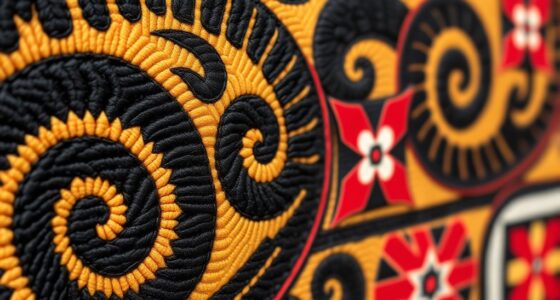Silk Road rugs reflect centuries of trade, cultural exchange, and artistic evolution across Persia, China, Central Asia, and beyond. Their designs blend geometric, floral, and symbolic motifs, shaped by regional styles and influences from various dynasties. Techniques like knotting and natural dyes enhance their vibrancy and craftsmanship. As you explore further, you’ll discover how these textiles tell stories of shared heritage, innovation, and the enduring legacy of the ancient trade routes.
Key Takeaways
- Silk Road trade routes facilitated the exchange of materials, motifs, and techniques among artisans, shaping diverse and intricate rug designs.
- Early silk road rugs feature simple geometric patterns that evolved into complex floral and symbolic motifs through cultural blending.
- Regional influences from Persia, China, and Central Asia contributed unique styles, with Persian floral patterns, Chinese auspicious symbols, and Central Asian bold geometries.
- Advanced dyeing and weaving techniques, along with symbolic motifs, reflect the cultural and spiritual values of Silk Road societies.
- Trade and cultural exchanges continue to influence modern Silk Road-inspired rug designs, preserving historical motifs and innovative craftsmanship.
Origins and Early Influences of Silk Road Rugs
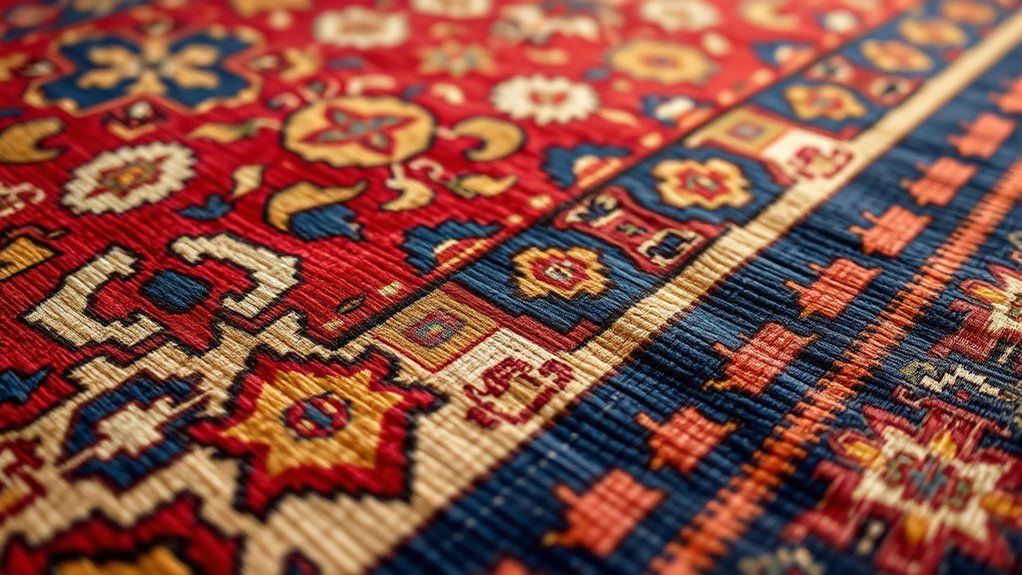
The origins of Silk Road rugs trace back to ancient Persia and Central Asia, where weaving traditions flourished long before trade routes connected distant lands. As these routes developed, they profoundly influenced local craftwork, introducing new styles and techniques. Trade route influences allowed artisans to exchange ideas, materials, and motifs, shaping early weaving techniques into more intricate and vibrant designs. You’ll notice that the earliest rugs display simple geometric patterns, reflecting practical needs and regional aesthetics. Over time, these techniques evolved with the blending of cultures, leading to more complex motifs and better-quality materials. This fusion of influences created a rich foundation for the diverse and vibrant Silk Road rugs that we admire today, rooted in centuries of tradition and cross-cultural exchange. Additionally, the incorporation of artistic motifs from different regions helped craft unique and enduring designs that continue to inspire modern weavers.
Key Regions and Their Artistic Signatures
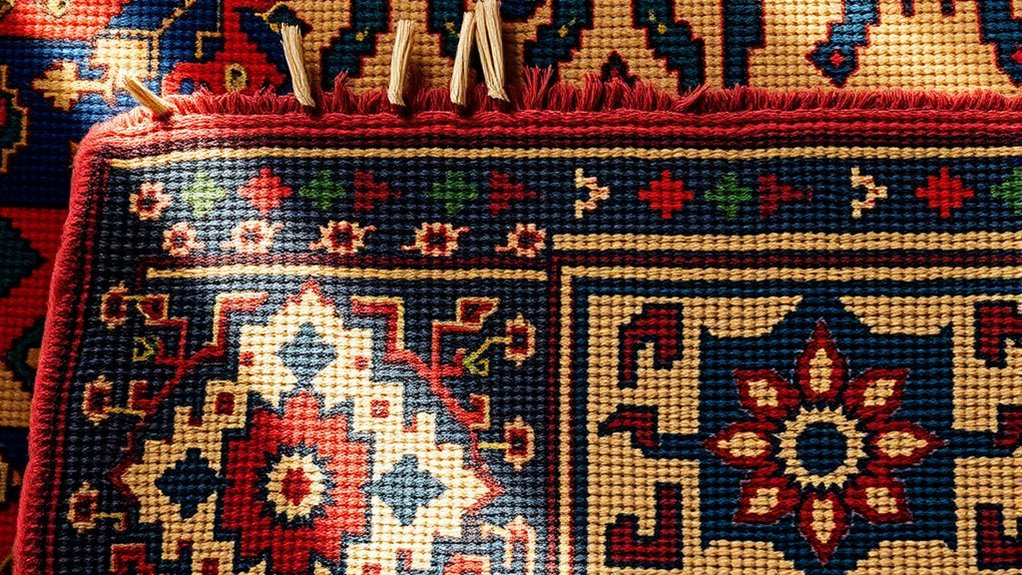
Persian rugs are renowned for their intricate designs and rich artistic heritage, reflecting centuries of cultural tradition. Central Asian motifs bring bold patterns and symbolic elements that distinguish their craftsmanship. Understanding these signatures helps you appreciate the unique character each region contributes to the Silk Road rug legacy. Additionally, recognizing regional design elements can enhance your overall appreciation of antique and modern pieces alike.
Persian Artistic Heritage
Many regions within Iran have developed distinctive artistic styles that define their unique contributions to Persian cultural heritage. In particular, Persian calligraphy showcases elegant scripts like Nasta’liq, reflecting spiritual and poetic traditions. Traditional weaving techniques, passed down through generations, create intricate patterns that embody regional identities. For example, Shiraz is known for its refined carpets featuring floral motifs, while Tabriz produces rugs with bold geometric designs. These art forms highlight Iran’s rich history of craftsmanship and aesthetic refinement. The combination of calligraphy and weaving influences shapes the visual language of Persian art, emphasizing harmony and detail. Additionally, regional weaving techniques contribute to the diversity of designs seen across different areas, illustrating the depth of Iran’s artistic mastery. By exploring these regional signatures, you gain insight into how Persia’s artistic heritage continues to influence the design and cultural identity of Silk Road rugs today.
Central Asian Motifs
Central Asian regions have developed their own distinctive motifs that stand out in Silk Road rugs, reflecting their rich cultural influences and local traditions. You’ll notice nomadic patterns that symbolize movement, protection, and spiritual beliefs, often inspired by daily life and nature. Geometric designs dominate these rugs, characterized by bold shapes, sharp lines, and symmetrical arrangements. These motifs serve both decorative and functional purposes, representing tribal identities and conveying stories or beliefs. The use of vibrant colors and intricate patterns highlights the craftsmanship passed down through generations. As you examine these rugs, you’ll see how the motifs encapsulate the nomadic lifestyle and the region’s artistic heritage. Awareness of these motifs reveals a deep connection between culture, environment, and the distinctive aesthetic of Silk Road textiles.
Materials and Techniques in Traditional Rug Making

You’ll notice that traditional rug making relies heavily on natural dye sources like plants, insects, and minerals to create vibrant colors. The knotting and weaving methods, such as the symmetrical and asymmetrical techniques, give each rug its unique texture and pattern. Understanding these materials and techniques helps reveal the craftsmanship behind Silk Road rugs. Additionally, color accuracy plays a crucial role in achieving the rich, authentic hues characteristic of these textiles.
Natural Dye Sources
Natural dyes form the vibrant foundation of traditional rug making, sourced from plants, minerals, and insects. You engage in natural dyeing by extracting pigments from botanical sources like indigo leaves, pomegranate skins, and madder roots. These natural sources provide a rich palette that influences the rug’s colors and character. The process involves careful preparation, such as soaking or boiling materials to release their hues, which are then used to dye the wool or silk fibers before weaving. The use of botanical sources guarantees that the colors are both vibrant and durable, often developing a unique patina over time. Additionally, natural dyeing techniques emphasize sustainability and environmental consciousness, reflecting the cultural and ecological values of Silk Road communities. By relying on natural dyeing techniques, artisans preserve centuries-old traditions, creating rugs that reflect the cultural and environmental diversity of the Silk Road region.
Knotting and Weaving Methods
Traditional rug making employs a variety of knotting and weaving techniques that give each piece its unique character and durability. Your choice of knotting techniques influences the rug’s texture, strength, and appearance. Different regions favor specific weaving patterns, such as the symmetrical Turkish knot or the asymmetrical Persian knot. You might see dense, intricate knots that create detailed designs or looser patterns for a more airy look. The weaving process often involves layering warps and wefts with precision, resulting in textured surfaces. Techniques like pile knotting or flat weaving add distinct qualities, shaping the rug’s overall style. To visualize, consider the following:
- Tight, dense knots forming detailed motifs
- Loose, open knotting for lighter textures
- Symmetrical versus asymmetrical weaving patterns
- Layered warps creating depth
- Variations in pile height and density
Iconic Motifs and Symbolism in Silk Road Textiles
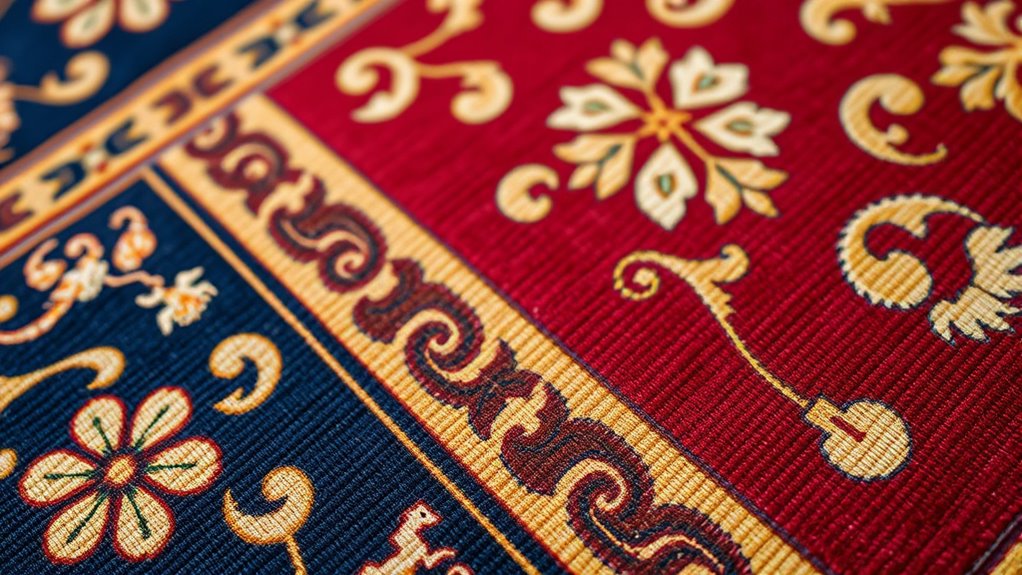
Silk Road textiles are renowned for their rich array of motifs and symbols that carry deep cultural significance. You’ll notice the use of symbolic animals, such as lions, dragons, and phoenixes, which represent power, protection, and renewal. Geometric patterns also play a crucial role, often symbolizing harmony, eternity, and the universe’s order. These motifs aren’t just decorative; they reflect beliefs, spiritual values, and social status. When examining textiles, you see how each symbol is carefully chosen to convey specific meanings, connecting the wearer or owner to broader cultural narratives. The combination of symbolic animals and geometric patterns creates intricate designs that serve both aesthetic and symbolic functions, revealing the diverse influences and traditions woven into Silk Road textiles. Additionally, the use of symbolic motifs helps preserve cultural identity across different regions and time periods.
The Impact of Trade and Cultural Exchanges on Design Styles
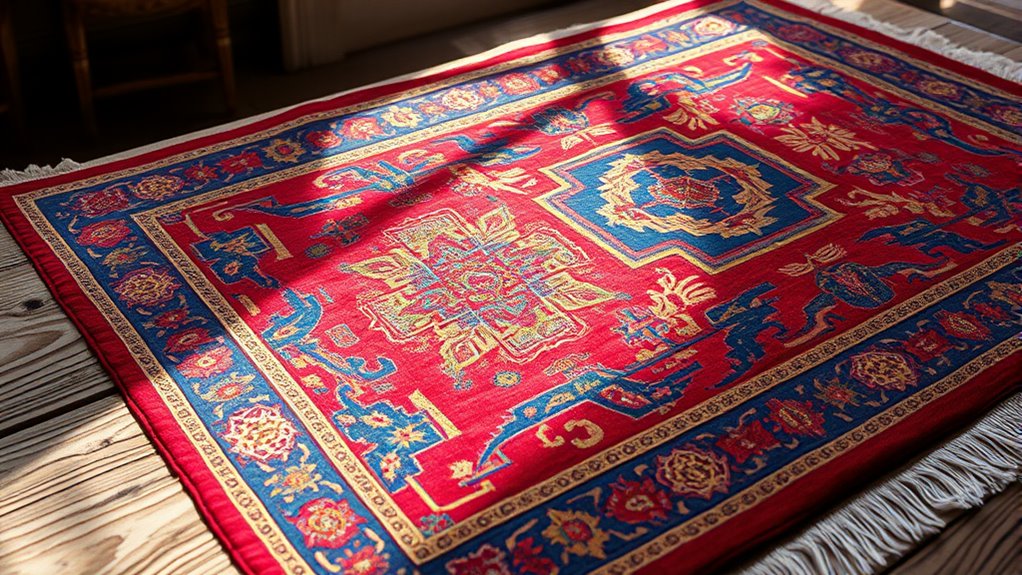
Trade and cultural exchanges along the Silk Road have profoundly shaped the design styles of textiles by introducing diverse motifs, techniques, and materials. This trade influence led to a fusion of artistic elements, creating unique and vibrant patterns. As you explore these textiles, you’ll notice:
- Intricate geometric designs inspired by Central Asian artistry
- Floral motifs influenced by Chinese and Persian traditions
- Use of new dyes extracted through advanced techniques
- Incorporation of symbols from various cultural beliefs
- Varied weaving methods blending different regional skills
These exchanges fostered a dynamic visual vocabulary, reflecting a shared cultural heritage. Your appreciation deepens as you recognize how trade influence and cultural exchange enriched Silk Road textiles, making them symbols of cross-cultural dialogue and artistic innovation. The resale value of these textiles further underscores their enduring cultural significance.
Evolution of Patterns Through Different Dynasties

As patterns on textiles evolved over time, different dynasties played a pivotal role in shaping their characteristics. You’ll notice that weaving symbolism became more intricate, reflecting cultural values and beliefs. During certain periods, patterns emphasized geometric designs, symbolizing order and harmony, while others incorporated floral motifs representing nature’s bounty. The pattern evolution across dynasties reveals shifting aesthetic preferences and technical advances in weaving techniques. Some rulers favored bold, repetitive motifs to demonstrate power, whereas others preferred detailed, delicate designs to showcase craftsmanship. These changes weren’t random; they mirrored societal changes, religious influences, and trade interactions. By understanding the pattern evolution through different dynasties, you gain insight into the cultural identity and historical context embedded within each textile, making each piece a story of its time. Additionally, the integration of traditional weaving practices highlights the importance of Indigenous Wisdom for Health Products in maintaining cultural heritage and craftsmanship.
The Role of Persian, Chinese, and Central Asian Styles
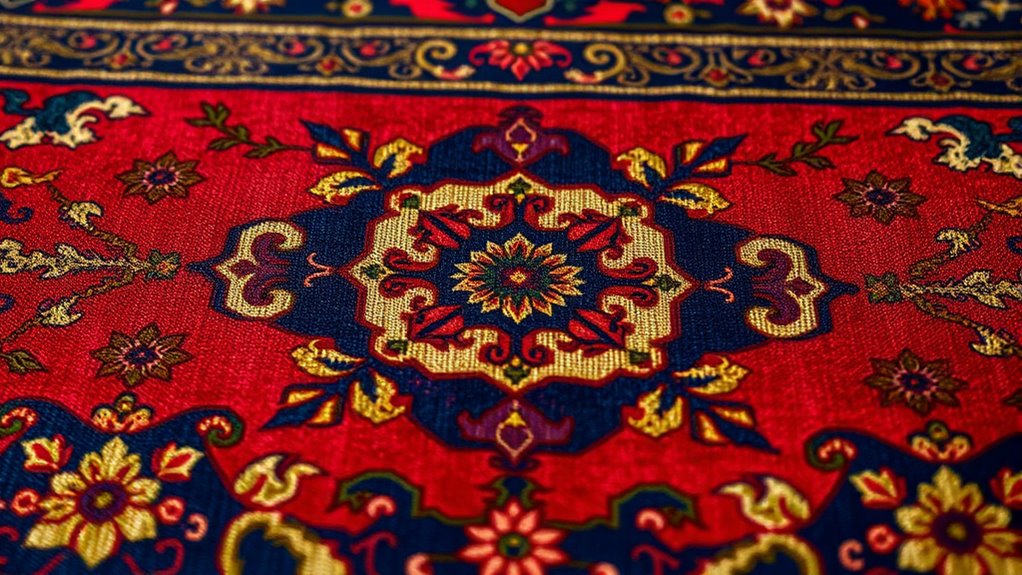
Persian, Chinese, and Central Asian styles have profoundly influenced the design and symbolism of Silk Road rugs, each bringing unique motifs and techniques that enrich the textiles’ cultural significance. Persian carpets are renowned for intricate floral patterns, medallions, and rich color palettes that symbolize paradise and spirituality. Chinese textiles contribute auspicious symbols like dragons, phoenixes, and cloud motifs, reflecting harmony and good fortune. Central Asian styles incorporate bold geometric designs, tribal symbols, and vibrant dyes, emphasizing community and tradition. These influences blend seamlessly, creating rugs that tell stories of trade, cultural exchange, and craftsmanship. The integration of design elements from various regions showcases the complexity and historical depth of Silk Road textiles. Whether it’s the delicate weaving of Persian carpets, the symbolic imagery in Chinese textiles, or the earthy motifs of Central Asian rugs, each style offers a window into its cultural roots.
Modern Resurgence and Preservation of Silk Road Rug Heritage

Today, the rich heritage of Silk Road rugs faces both challenges and opportunities as artisans and enthusiasts work to preserve and revitalize these timeless textiles. Contemporary craftsmanship plays a crucial role, blending traditional techniques with modern innovation to keep the craft alive. Many artisans incorporate Silk Road-inspired motifs into new creations, making these rugs relevant for today’s aesthetics. You’ll find that modern interior design increasingly features these rugs as statement pieces, adding cultural depth and visual richness. Preservation efforts include supporting local weavers and promoting education about their cultural significance. Embracing both tradition and modernity, and fostering creative practice, help guarantee the Silk Road rug heritage remains vibrant, inspiring future generations to appreciate these exquisite textiles beyond their historical context.
Collecting and Appreciating Antique Silk Road Rugs
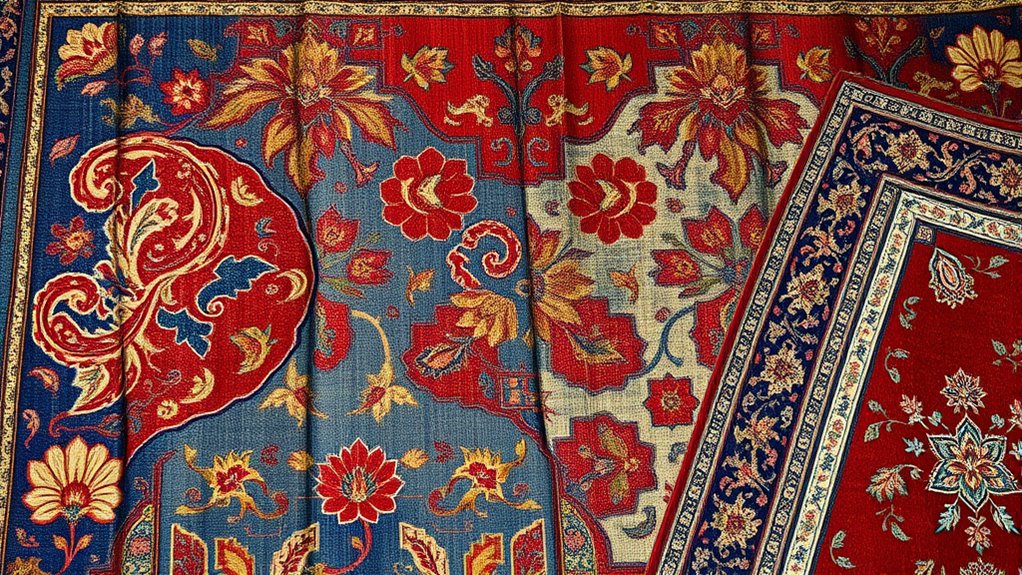
Ever wondered what makes antique Silk Road rugs so highly prized among collectors? It’s their rich weaving symbolism and unique history that draw you in. When collecting, focus on authentic pieces with clear provenance and vibrant, well-preserved colors. To appreciate their craftsmanship, observe the intricate knotwork and traditional motifs. Keep these rug collection tips in mind:
- Check the rug’s age and origin for authenticity
- Examine the condition and signs of restoration
- Study the weaving symbolism for cultural significance
- Consider the rug’s size and suitability for display or use
- Seek reputable dealers to ensure quality and provenance
Additionally, understanding the celebrity transformations involved in the restoration and preservation of antique rugs can shed light on their value and historical importance.
Frequently Asked Questions
How Do Silk Road Rugs Influence Contemporary Interior Design?
Silk Road rugs influence your contemporary interior design by adding rich patterns and vibrant colors that create striking focal points. They blend seamlessly with contemporary minimalism, providing texture and warmth without overwhelming space. You can incorporate these rugs into furniture integration, where their intricate designs complement sleek, modern pieces. This mix of old-world craftsmanship and modern aesthetics elevates your home, making it both stylish and culturally rich.
What Conservation Methods Are Used for Preserving Antique Silk Road Rugs?
When it comes to preserving antique Silk Road rugs, you’re in good hands with specialized conservation methods. Experts use delicate restoration techniques to repair damage and stabilize fibers, ensuring the rug’s integrity. Environmental controls, like controlled humidity and temperature, prevent deterioration over time. Think of it as tending a fragile treasure—careful handling keeps its history alive, allowing you to enjoy its beauty for generations to come.
Are There Regional Variations in Dye Techniques Across Silk Road Routes?
You’ll notice regional dye techniques vary across the Silk Road routes, reflecting local resources and traditions. For example, Central Asian rugs often feature vibrant vegetable dyes, while Persian pieces may use more complex mineral dyes. These regional dye techniques shape unique cultural dye patterns, highlighting each area’s artistic identity. By examining these variations, you gain insight into the diverse craftsmanship and cultural influences that influenced Silk Road rug design.
How Do Modern Artisans Incorporate Traditional Motifs Into New Rug Designs?
Modern artisans masterfully merge tradition with trend by meticulously mirroring motifs and mythologies, making timeless techniques fashionable. They incorporate intricate weaving techniques and motif symbolism, blending old patterns with innovative ideas. By boldly balancing history and modernity, they create enthralling, culturally rich creations. This thoughtful fusion ensures that age-old artistry remains alive, appealing to contemporary tastes while honoring the heritage woven into every thread of these stunning, symbolic rugs.
What Are the Challenges in Authenticating Antique Silk Road Rugs?
You face challenges in authenticating antique Silk Road rugs because provenance verification can be complicated due to unclear ownership histories. Material analysis helps determine the age and origin of fibers, but it requires specialized expertise and equipment. These methods, combined with examining weaving techniques and dyes, are essential for accurate authentication. However, the rarity and market for these antiques often make it difficult to verify their true origin confidently.
Conclusion
As you explore Silk Road rugs, you’re stepping into a tapestry woven with centuries of stories, colors, and cultures. These textiles are like woven time capsules, whispering secrets of ancient trade winds and nomadic dreams. By appreciating their intricate patterns and vibrant history, you’re part of a living tradition that dances across borders. So, let these rugs inspire your space, turning your home into a vibrant mosaic of history and artistry.






